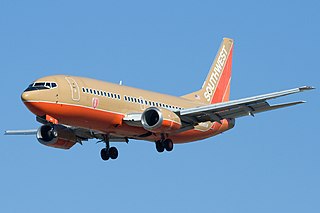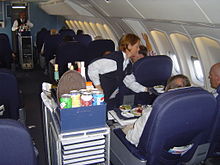United Airlines, Inc. is a major American airline headquartered at Willis Tower in Chicago, Illinois. United operates a large domestic and international route network spanning cities large and small across the United States and all six inhabited continents. Measured by fleet size and the number of routes, it is the third-largest airline in the world after its merger with Continental Airlines in 2010.
Continental Airlines, simply known as Continental, was a major American airline founded in 1934 and eventually headquartered in Houston, Texas. It had ownership interests and brand partnerships with several carriers.

Hewanorra International Airport, located near Vieux Fort Quarter, Saint Lucia, in the Caribbean, is the larger of Saint Lucia's two airports and is managed by the Saint Lucia Air and Seaports Authority (SLASPA). It is on the southern cape of the island, about 53.4 km (33.2 mi) from the capital city, Castries.

A low-cost carrier or low-cost airline is an airline that is operated with an especially high emphasis on minimizing operating costs and without some of the traditional services and amenities provided in the fare, resulting in lower fares and fewer comforts. To make up for revenue lost in decreased ticket prices, the airline may charge extra fees – such as for carry-on baggage. As of April 2020, the world's largest low-cost carrier is Southwest Airlines, which operates primarily in the United States, as well as in some surrounding areas.

Catering is the business of providing food service at a remote site or a site such as a hotel, hospital, pub, aircraft, cruise ship, park, festival, filming location or film studio.

The Armstrong Whitworth Argosy was a British post-war transport/cargo aircraft; it was the final aircraft to be designed and produced by aviation company Armstrong Whitworth Aircraft. Although given different internal design numbers, the AW.650 civil and AW.660 military models were, for most practical purposes, the same design, while both models also shared the "Argosy" name.

Business class is a travel class available on many commercial airlines and rail lines, known by brand names which vary, by airline or rail company. In the airline industry, it was originally intended as an intermediate level of service between economy class and first class, but many airlines now offer business class as the highest level of service, having eliminated first-class seating. Business class is distinguished from other travel classes by the quality of seating, food, drinks, ground service and other amenities. In commercial aviation, full business class is usually denoted 'J' or 'C' with schedule flexibility, but can be many other letters depending on circumstances.

In aviation, aircraft ground handling defines the servicing of an aircraft while it is on the ground and (usually) parked at a terminal gate of an airport.

Kelowna International Airport is a Canadian airport located approximately 10 minutes or 6.2 nautical miles northeast of Kelowna, British Columbia, Canada, on Highway 97.
GoJet Airlines LLC is a regional airline headquartered in Bridgeton, Missouri, United States. Wholly owned by Trans States Holdings, it has 1,670 employees. It operates commuter feeder services under the United Express brand of United Airlines. United Express flights are currently operated out of United's hubs at Chicago–O'Hare, Newark and Washington-Dulles. GoJet's Delta Connection branded flights came to an end on March 31, 2020. Most of the flying at the end of the agreement was out of Detroit and Minneapolis–St. Paul as well as Raleigh-Durham. GoJet Airlines' system operations center (SOC), training center and corporate offices are co-located in the former Trans World Airlines and Ozark Airlines training center in Bridgeton, Missouri. The airline uses the former McDonnell Douglas factory hangar at Saint Louis Lambert International Airport as its primary maintenance facility, with maintenance staff available at all of the airline's destinations. Its call sign, "Lindbergh", is named for aviation pioneer Charles Lindbergh, who flew the Spirit of St. Louis solo across the Atlantic Ocean in 1927: the first person to do so.

An airline meal, airline food, or in-flight meal is a meal served to passengers on board a commercial airliner. These meals are prepared by specialist airline catering services and normally served to passengers using an airline service trolley.

Sunshine Coast Airport is an Australian international airport located at the northern end of the Sunshine Coast and approximately 90 km (56 mi) north of centre of Brisbane, within South East Queensland agglomeration. It is the principal airport for the Sunshine Coast and is the only airport in the region capable of servicing jet aircraft operations.

Al Maktoum International Airport, also known as Dubai World Central, is an international airport in Jebel Ali, 37 kilometres (23 mi) southwest of Dubai, United Arab Emirates that opened on 27 June 2010. It is the main part of Dubai South, a planned residential, commercial and logistics complex.

The galley is the compartment of a ship, train, or aircraft where food is cooked and prepared. It can also refer to a land-based kitchen on a naval base, or, from a kitchen design point of view, to a straight design of the kitchen layout.

Ground support equipment (GSE) is the support equipment found at an airport, usually on the apron, the servicing area by the terminal. This equipment is used to service the aircraft between flights. As the name suggests, ground support equipment is there to support the operations of aircraft whilst on the ground. The role of this equipment generally involves ground power operations, aircraft mobility, and cargo/passenger loading operations.

Premium economy class, also known as elite economy class or economy plus class, is a travel class offered on some airlines. It is usually positioned between standard economy class and business class in terms of price, comfort, and available amenities. In 1991, EVA Air was the first to introduce Evergreen Class, becoming the first airline to offer this class of service. It can be said that in many ways, Premium Economy class has become a standard reflection of what Economy class was like several decades ago. In some countries, this class has emerged as a response from governments and companies requiring economy class for travel done by staff.

The Boeing 737 Classic is a series of narrow-body airliners produced by Boeing Commercial Airplanes, the second generation of the Boeing 737 series of aircraft. Development began in 1979 and the first variant, the 737-300, first flew in February 1984 and entered service that December. The stretched 737-400 first flew in February 1988 and entered service later that year. The shortest variant, the 737-500, first flew in June 1989 and entered service in 1990.

A serving cart is a kind of smaller food cart. It is typically used by restaurants to deliver or display food.

On February 3, 1975, 197 people fell ill aboard a Japan Air Lines Boeing 747 en route from Anchorage, Alaska to Copenhagen, Denmark after consuming an in-flight meal contaminated with Staphylococci. 144 people needed hospitalization, making it the largest food poisoning incident aboard a commercial airliner.
















